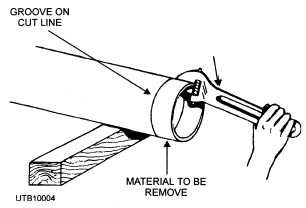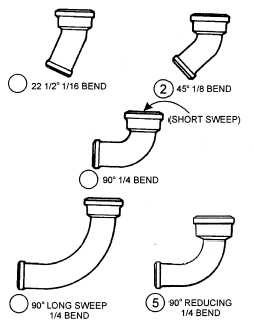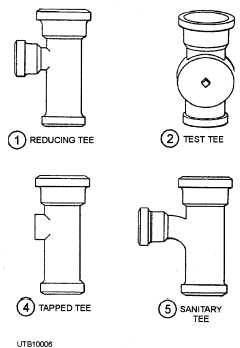
Figure 3-5. - Cutting cast-iron pipe with hacksaw and adjustable wrench.
of a hub and spigot). Thus the remaining pipe still has a hub, and it can be used.
FITTINGS. - Cast-iron soil pipe fittings are used for making branch connections or changes in the direction of a line. Both cast-iron soil pipe and fittings are brittle, so exercise care to avoid dropping them on a hard surface. Some of the cast-iron soil pipe fittings you may use in your work are described below.
A number of different types of bends are generally used on jobs involving cast-iron soil pipe. Some of the common types are the 1/16, 1/8, short sweep 1/4, long sweep 1/4, and reducing 1/4 bend. Look at figure 3-6 to get an idea of the shape and appearance of each of these types of bends.
The 1/16 bend is used to change the direction of a cast-iron soil pipeline 22 1/2 degrees. A 1/8 bend is used to change the direction of a cast-iron soil pipeline 45 degrees. The SHORT SWEEP 1/4 bend is a fitting used to change the direction of a cast-iron soil pipeline 90 degrees in a short space. The LONG SWEEP 1/4 bend is used to change the direction of a cast-iron soil pipeline 90 degrees, but more gradually than the short sweep 1/4 bend. The REDUCING 1/4 bend gradually changes the direction of the pipe 90 degrees, and in the sweep portion, it reduces nearly one size. A 4 by 3 reducing long sweep 1/4 bend has a 4-inch SPIGOT on one end, reducing 90 degrees to a 3 1/4-inch HUB on the other end. Note that for all CISP fittings, the spigot end is always listed first.
Tees connect branches to continuous lines. Learn to recognize the four designs of tees shown in figure 3-7. For connecting lines of different sizes, REDUCING tees are often suitable.
The TEST tee is used in stack and waste installations where the vertical stack joins the horizontal sanitary sewer (fig. 3-8). It is installed at this point, so the plumber can insert a test plug and fill the system with water in testing for tightness. The test tee is also used in multistory construction.
The TAPPED tee is frequently used in the venting system; it is called the main vent tee. The SANITARY tee is commonly used in a main stack to allow the takeoff of a cast-iron soil pipe branch.
Four types of cast-iron soil pipe 90-degree Y-branches are in general use, as shown in view A,

Figure 3-6. - Types of cast-iron soil pipe Types of cast-iron soil pipe bends.

Figure 3-7. - Cast-iron soil pipe tees.
Continue Reading